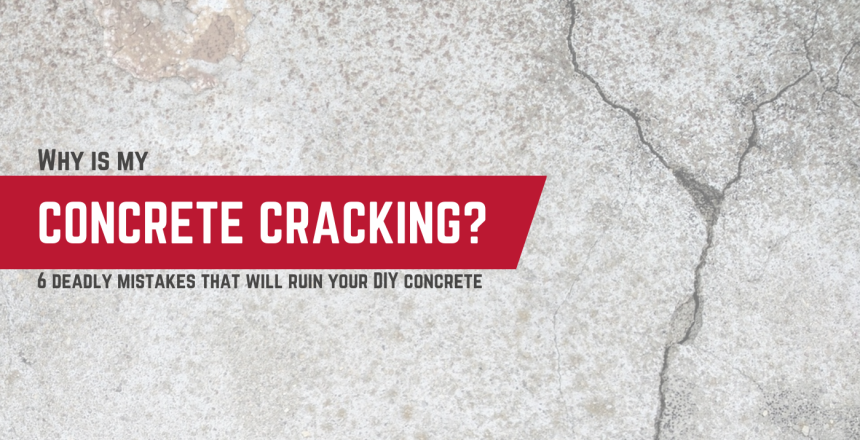DIY concrete projects are one of the best ways to boost home values, no matter what project you choose. But mixing and pouring concrete takes some science to get right.
If you don’t get it right, concrete cracking can ruin an entire project and cancel all that financial gain. But with the right knowledge, you can keep your concrete looking pristine for years.
Why Is My Concrete Cracking?
There are several reasons why you might start seeing your concrete crack after your project is done, and most of those reasons are generally avoidable if you start right. And when it can’t be avoided, you can at the very least decrease the extent of the cracking. Here are our top six factors that lead to your concrete cracking.
The Wrong Materials
DIY concrete for driveways, patios, sidewalks, or decorative work can be a great way to save money and bump up your home value. But if you don’t know the difference between types of concrete before you start, you could end up with serious problems. The key is the compressive strength rating of your concrete mix.
To Prevent Cracking Concrete from Weight:
Check the load capacity for your concrete. Decorative concrete can’t handle the high compressive force of vehicles, so you’ll need high-strength concrete for driveways. The compression rating for driveways should be at least 8,000 psi. For sidewalks or decorative work, regular concrete mixes work well, with around a 4,000 psi rating.
Too Much or Too Little Moisture in the Mix
When pouring concrete, moisture levels are crucial to proper curing. The chemical reaction between cement (the active ingredient), aggregate (sand and gravel), and moisture is what makes the concrete strong. When those ratios are off, you’ll end up with concrete that cracks easily.
Concrete with too much moisture, although it may be easier to work with during installation, will suffer from higher levels of shrinkage. As the excess water evaporates, the concrete shrinks more than it should. This increased shrinking results in cracking under even normal compressive loads.
On the opposite side, concrete with too little moisture will end up brittle and weak since the drying process will not take long enough to cure the concrete to its full strength.
To Get Your Moisture Levels Correct:
When you mix your concrete, follow the manufacturer’s directions. However, if you’re expecting extreme heat or cold during the curing period, make sure you’re taking steps to adjust your moisture levels to the conditions to prevent unwanted concrete cracking.
Concrete Dried Too Fast
In the hottest temperatures, or when the concrete is mixed too dry, concrete cracking can occur due to poor curing. During hydration (when the Portland cement is chemically reacting to water in the mixture), the mix crystallizes and forms bonds with the aggregate. This is how the concrete gets its strength.
But if the concrete dries too fast, those crystals don’t form completely, leaving the finished product weaker than it should be. Sometimes this rapid drying is caused by excessive heat, but sometimes it’s caused by too little moisture in the concrete mix at the start.
To Prevent Concrete from Drying Too Fast:
The best prevention for this problem is to get moisture levels correct at the beginning. If you’re planning on pouring and setting concrete when temperatures are in excess of 85 degrees, plan to either add more water to the mix or protect the mix from direct heat exposure by covering it with a plastic barrier.
This is a difficult balance, but knowing your situation can prevent costly repairs when you eventually see your concrete cracking.
Control Joints Aren’t Placed Properly
Control joints are placed in concrete slabs in order to accommodate the natural expansion and contraction they experience with weather and water changes. But if you don’t place the joints correctly, they won’t be able to provide the stress relief necessary to prevent concrete cracking.
And for DIY concrete projects, this becomes a common mistake when projects go from small to big.
To Prevent Concrete Cracking Due to Control Joint Issues:
The solution, thankfully, is simple. Any time you pour concrete, plan out a control joint that matches the proper ratio for your concrete’s thickness.
For example, a 5-inch thick concrete slab for a driveway will require control joints for every 10 to 15 feet of concrete. In comparison, a 3-inch thick slab will need control joints for every 6 to 9 feet of concrete.
Extreme Temperature Changes
We’ve mentioned this a few times above, but it’s the most common cause of concrete cracking, especially in DIY concrete projects. Pouring concrete in extreme heat and cold creates issues for curing, but just the simple strain of temperature changes can wreak havoc on concrete from the inside out.
When water freezes and thaws, it naturally expands and contracts. But since concrete loses most of its elasticity after curing, it can’t handle the strain these changes and cycles cause. Instead, it cracks under the added stress.
But with some care and maintenance, you can minimize the effects of these temperature changes.
To Decrease Temperature-Related Concrete Cracking:
At least once every year, take the time and effort to seal your concrete in order to decrease the damage of the freeze-thaw cycle. With a good seal coat, you can keep your concrete in top shape for years. These waterproof coatings prevent moisture from seeping into the concrete during wet seasons, allowing the concrete to remain strong and stress-free during extremely cold seasons.
Ground Movement
Yes, earthquakes can cause concrete cracking in the most extreme cases. But you don’t have to live on a fault line to see the effects of ground movement on concrete. In areas with sandy or coarse soil, changes in soil water levels can have devastating effects on concrete slabs, foundations, and decorative patios.
But concrete cracking is possible when soil is simply not properly prepared for pouring the concrete.
To Prevent Ground Movement Issues:
When you start planning for your DIY concrete project or driveway, determine what your underlying soil will need for prep work. Sandy or overly coarse soil will likely need some additional aggregate to keep it from soaking up too much water or sliding from additional weight. All underlying soil should be compressed to make sure it doesn’t shift or settle too much after pouring.
It’s also important that the site is kept intact prior to laying the concrete. Use tarps to prevent pooling water from excess rain if you foresee a gap between prepping the site and pouring the concrete.
Hiring Professionals for Pouring Concrete
There’s a lot to think about when it comes to pouring your own concrete for a DIY project, and there are many opportunities for mistakes that result in concrete cracking once the project is done. For those willing to do the heavy lifting of researching, planning, and prepping for the projects properly, it can be a great way to save some money while improving your home’s functionality and value.
But for those who want to guarantee a great end product, it’s worth considering the cost of hiring a professional team for your residential decorative or flat work concrete. When the job feels like too much, we’ve got you covered. With more than 50 years in the business, we can get your project done quickly, and with the highest level of quality. Contact us today and start your home improvement project with confidence.



